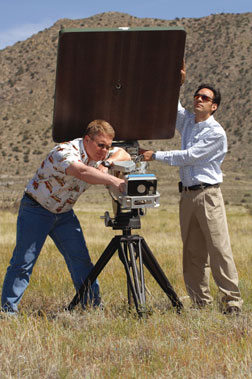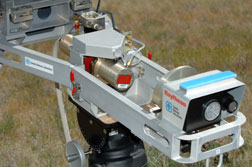NEWS RELEASES
FOR IMMEDIATE RELEASE
June 30, 2005
Team investigates Active Denial System for security applications
Millimeter-wave device puts the ‘heat’ on adversaries
 Nonlethal weaponry — Sandia researchers Willy
Morse and James Pacheco fine-tune the small-sized Active
Denial System. (Photo by Randy Montoya)
Nonlethal weaponry — Sandia researchers Willy
Morse and James Pacheco fine-tune the small-sized Active
Denial System. (Photo by Randy Montoya)Download 300dpi JPEG image, “nonlethal-weaponry.jpg,” 988K (Media are welcome to download/publish this image with related news stories.)
ALBUQUERQUE, N.M. — A multi-organizational team is adapting for DOE use a technology that can help keep security adversaries out of DOE sites that contain nuclear assets.
The DOE Office of Security and Safety Performance Assurance (SSA) is exploring the potential to use directed energy weapons technology sponsored by the Department of Defense (DoD), named Active Denial Technology (ADT), to help protect DOE nuclear assets.
SSA is sponsoring Sandia National Laboratories, a National Nuclear Security Administration lab, to investigate how the technology can be used on adversaries by developing a new small-sized Active Denial System (ADS) to meet the unique and rapidly evolving security needs of DOE.
To help solve the many technical issues associated with this challenge, Sandia has partnered with Raytheon and the Air Force Research Laboratory (AFRL), because both organizations have significant experience with earlier ADS system developments.
ADS systems are a new class of nonlethal weaponry using 95 GHz-millimeter-wave directed energy. This technology is capable of rapidly heating a person’s skin to achieve a pain threshold that has been demonstrated by AFRL human subject testing to be very effective at repelling people, without burning the skin or causing other secondary effects.
The device is an alternative to lethal force.
In the mid 1990s the Air Force funded development of an ADT system demonstrator that was led by AFRL and built by Raytheon in partnership with Communications & Power Inc. (CPI) and Malibu Research. The success of this demonstration system has resulted in several ongoing DoD-sponsored projects, such as the Joint Non-Lethal Weapons Directorate’s Vehicle Mounted Active Denial System (VMADS) and the Office of Force Transformation’s (OFT’s) project SHERIFF.
 ADS — The new class of nonlethal weaponry
uses 95 GHz-millimeter-wave directed energy. (Photo
by Randy Montoya)
ADS — The new class of nonlethal weaponry
uses 95 GHz-millimeter-wave directed energy. (Photo
by Randy Montoya)Download 300dpi JPEG image, “directed-energy.jpg,” 644K (Media are welcome to download/publish this image with related news stories.)
Steve Scott, manager of Sandia’s Access Delay Technology Department, says, “DOE and Sandia have been closely tracking ADT developments and have recognized its potential to enhance the protection of DOE nuclear facilities. This has been confirmed by conducting a feasibility study in 2002, under the supervision of researcher Jim Pacheco.”
Acting on the feasibility study’s conclusions, SSA’s Carl Pocratsky (SO-20) initiated an effort at Sandia to explore and develop a small Active Denial System (ADS) that is more suitable for DOE fixed-site applications. To date, DoD efforts have focused on larger systems, considered by many to be better suited for military applications at extended ranges.
In 2004, the AFRL’s Human Effectiveness Directorate (HEDR) completed a study that analyzed pre-existing test data to estimate the potential effectiveness of an ADS that has a smaller beam. Also in 2004, Sandia conducted simulations of how the smaller ADS might be used and how it would perform against adversary attack scenarios within a DOE facility using the Joint Conflict and Tactical Simulation (JCATS) software modeling tool.
“The results of the AFRL small beam ADS effectiveness study and the JCATS study were very encouraging and provided a strong basis for continuing the development of a comparitively small ADS for DOE fixed-site applications,” says Pacheco.
“Recently there has been significant progress with this project,” says Willy Morse, Sandia’s principal investigator. “On May 5 we took acceptance of the SSA ADS prototype system built by Raytheon’s Advanced Electromagnetic Technologies (AET) Center in partnership with CPI and Malibu Research. Initial characterization and performance tests were completed at the end of May.”
On May 19 a memorandum of understanding was completed between DOE-SSA, Sandia, DoD-OFT, and AFRL. This memorandum establishes a formal partnership between the DoD and DOE in developing small-sized ADSs. During the next six months the AFRL’s Human Effectiveness Directorate, Brooks City-Base, is being funded by the OFT to complete human effects testing. This testing will use the SSA ADS system to determine its effectiveness for DOD applications and validate the conclusions of the 2004 small-beam-size effectiveness study sponsored by SSA.
Testing results from Sandia, AFRL, and OFT will guide the operational concept and design of a second-generation small-size ADS system expected to be fielded at several DOE nuclear facilities as early as 2008. DOE-SSA and Sandia will continue to actively seek opportunities to collaborate with other government agencies on technical issues associated with developing and deploying ADS systems.
System uses beam of electromagnetic energy to heat
human
Active Denial Technology (ADT) provides an effective nonlethal
active-response mechanism to disperse, disturb, distract,
and establish the intent of intruders.
ADT emits a 95 GHz non-ionizing electromagnetic beam of energy that penetrates approximately 1/64 of an inch into human skin tissue, where nerve receptors are concentrated. Within seconds, the beam will heat the exposed skin tissue to a level where intolerable pain is experienced and natural defense mechanisms take over.
This intense heating sensation stops only if the individual moves out of the beam’s path or the beam is turned off. The sensation caused by the system has been described by test subjects as feeling like touching a hot frying pan or the intense radiant heat from a fire. Burn injury is prevented by limiting the beam’s intensity and duration.
DoD-sponsored millimeter-wave human effectiveness testing, initiated in 2001, has demonstrated ADT as both effective and safe without any long-term effects. It is expected that the DoD-funded human effectiveness testing of the small-beam ADS by the AFRL HEDR during the next six to eight months will validate its effectiveness and safety as a nonlethal weapon system.
Sandia is a multiprogram laboratory operated by Sandia Corporation, a Lockheed Martin company, for the U.S. Department of Energy’s National Nuclear Security Administration. Sandia has major R&D responsibilities in national security, energy and environmental technologies, and economic competitiveness.
Sandia media contact: Michael Padilla, mjpadil@sandia.gov, (505) 284-5325